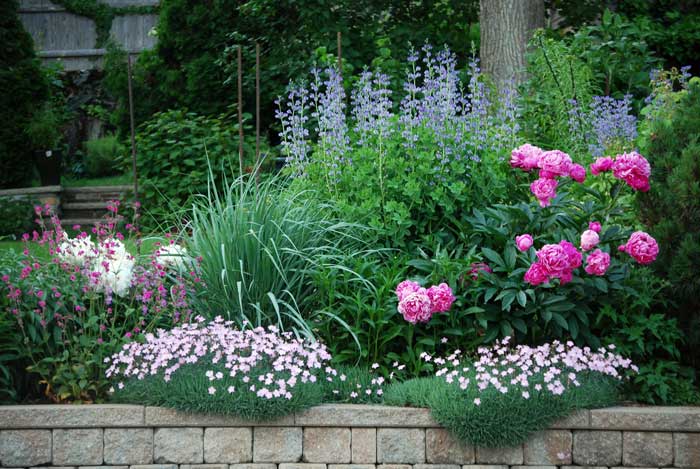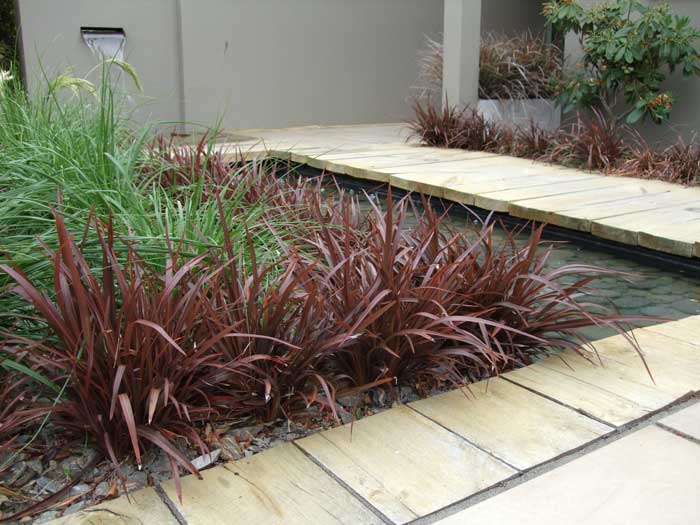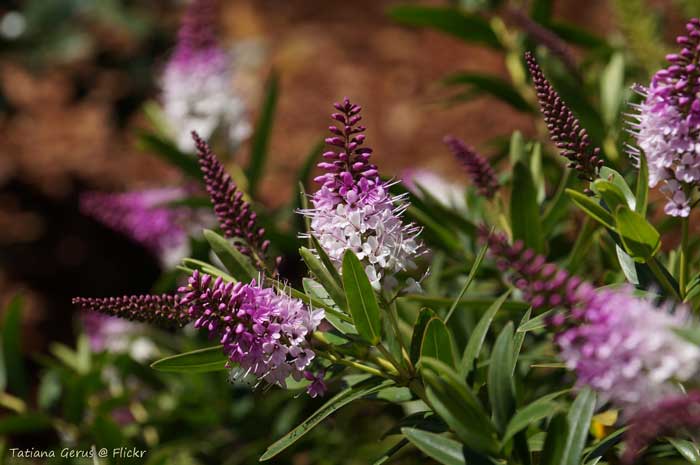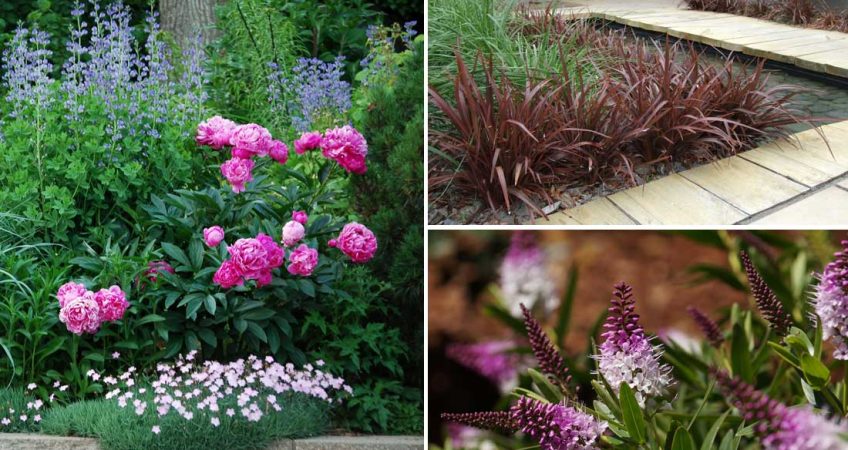Ever wondered how some gardens manage to maintain their vibrant allure throughout the year? The answer could lie in the strategic use of perennial plants. This comprehensive guide will provide an understanding of perennial plants, their numerous benefits, and a highlight of popular perennial plants in New Zealand.
We’ll also share tips on cultivating these plants successfully in your garden or landscaping project.
- Perennial plants come in all shapes and sizes.

Understanding Perennial Plants
What are Perennial Plants?
Perennial plants are nature’s gift that keeps on giving. Unlike annuals, which complete their life cycle in a single year, and biennials, which do so in two years, perennials live for more than two years. They grow, blossom, and produce seeds over many seasons, providing a continuous display of foliage and blooms.
There are two other strategies that plants employ, plus an additional category that we can use to classify plants in horticulture.
1. Annuals: These plants complete their life cycle in a single growing season. This means they germinate, grow, flower, produce seeds and die all within one year. Annuals need to be replanted each year, but they often provide vibrant and continuous colour throughout the growing season. Examples of annual plants include marigolds, petunias, and sunflowers.
2. Biennials: Biennial plants take two years to complete their life cycle. In the first year, these plants focus on growing leaves, stems, and roots, then enter a period of dormancy over the colder months. During the second year, they flower, produce seeds, and then die. Biennials require more patience than annuals or perennials, but can offer unique flowering displays. Examples of biennial plants include foxgloves, hollyhocks, and some types of parsley.
3. Tender perennials: These plants are perennial in nature but can’t survive cold winter temperatures. They’re often treated as annuals in colder climates. Examples include geraniums and begonias.
Perennial Flowers vs Annual and Biennial Flowers
Annual plants prioritise the “live fast, die young” mentality. They spend everything they have in a single year and tend to produce more flowers and seeds (especially in the first year) compared to perennials. They won’t be alive next year, so their job is to ensure they create enough seed to ensure the next generation’s survival.
Perennials, on the other hand, prioritise the “save it all for retirement” mentality. They don’t want to spend everything they have in the first year and try to live for many years, releasing seeds more carefully.
Biennial plants have a strategy somewhere between annuals and perennials, where they save up for a year, then live fast and die in their second year.
Benefits of Planting Perennials
Planting perennials means that you don’t have to plant new plants every one or two years, and you also don’t have bare patches while you wait for new plants to grow.
The deeper root systems of perennials contribute significantly to soil health by preventing erosion, enhancing water infiltration, and promoting nutrient cycling. This results in richer, more fertile soil that benefits other plants in your garden.
Popular Perennial Plants in New Zealand
Phormium spp.
Phormium, or New Zealand flax, is a native perennial celebrated for its striking architectural form and dramatic foliage. It thrives in full sun or partial shade and prefers well-drained soil. It requires regular watering during dry periods.
The plant is widely used in garden design for its beautiful shape, vibrant colours, and its strong fibres have been traditionally used in weaving by Māori, contributing to the cultural heritage of New Zealand.
2. As long as you keep your NZ flax healthy, it’ll stay alive for years and years. This is Sweet Mist™ Phormium tenax ‘PHOS2’ PVR. http://ozbreed.co.nz/plant-ranges/strappy-leaf-plants/sweet-mist-phormium/

Dianella spp.
Dianella, often referred to as Australian flax lilies, are admired for their attractive foliage and vibrant blue or purple berries. They can look a lot like NZ flax to the untrained eye, until they flower where you’ll notice they look completely different.
They prefer lightly shaded to sunny spots with well-drained soil. Their flowers attract buzz pollinators and colourful berries attract birds, promoting local biodiversity, while the texture and colour of the plants add depth to garden borders.
Viburnum spp.
Viburnums are exotic perennials offering a variety of leaf forms, flowering styles, and vibrant autumn colours. Most viburnums prefer full sun to partial shade and moist, well-drained soil.
Pruning after flowering helps maintain shape and promote vigorous growth. With their attractive flowers and foliage, viburnums make excellent specimen plants or privacy hedges, adding both beauty and function to your garden.
Pseudopanax spp.
Pseudopanax, also known as Lancewood or Five Finger, is a native New Zealand perennial that’s highly valued for its unique and diverse leaf forms. Young plants have long, narrow leaves that hang downwards, creating an interesting visual appeal. As the plant matures, the leaves become shorter and wider. This plant is highly adaptable and can grow in both sunny and shady conditions, making it a versatile choice for various garden designs.
Coprosma spp.
Coprosma, commonly referred to as mirror plant due to its glossy leaves, is a group of evergreen shrubs native to New Zealand. The different species offer a wide range of leaf colours and shapes, from vibrant oranges and reds to deep greens. These plants are highly tolerant of various conditions, thriving in both full sun and partial shade. They’re often used in landscaping for their striking foliage and as hedge plants due to their dense growth habit.
Hebe spp.
Hebe is the largest plant genus native to New Zealand and offers a broad array of shrubs varying in size, shape, and colour. Hebes are celebrated for their attractive foliage and abundant flowering, with colours ranging from white and pink to deep purple. They’re quite hardy and prefer well-drained soil and a sunny position. Their lovely blossoms attract butterflies, adding an extra touch of nature to your garden.
3. Hebes are perfect perennial plants for hedging or in a native NZ cottage garden.

Cordyline spp.
Cordyline, sometimes called the cabbage tree, is an iconic perennial of the New Zealand landscape. Known for its tall, slender trunk and tufted leaves, it adds a tropical feel to gardens. It’s a hardy plant, tolerating a range of soil types and weather conditions, but prefers full sun exposure. Its fragrant flowers attract bees, enhancing local biodiversity. While some species are native to New Zealand, others are native to nearby regions including Australia.
Metrosideros spp.
Metrosideros, also known as Pōhutukawa or New Zealand Christmas tree, is a coastal evergreen tree in the myrtle family, Myrtaceae, that produces a brilliant display of red flowers made up of a mass of stamens. The Pōhutukawa is one of twelve Metrosideros species endemic to New Zealand. Renowned for its vibrant colour and its ability to survive even perched on rocky, precarious cliffs, it’s found an important place in New Zealand culture for its strength and beauty.
Cultivating Perennial Plants in New Zealand
Many perennials thrive in New Zealand’s temperate climate. However, each species has specific requirements for sunlight, temperature, and soil type. Understanding these needs is crucial for successful cultivation.
For instance, some perennials may require full sun exposure, while others might need partial shade. Similarly, certain perennials may prefer sandy soil, while others might thrive in clay soil.
Some perennials are evergreen, while others will lose their foliage over the winter (deciduous) or may die back down to a bulb over the summer months (geophytes).
And while some perennials are easy to care for, others are notoriously difficult to care for.
Planting Techniques
Successful planting begins with quality soil. Dig a hole twice the width of the root ball, place the plant ensuring it’s level with the ground, backfill the hole, firm the soil and water thoroughly.
Early spring or autumn are typically ideal times for planting, allowing perennials to establish before extreme weather conditions.
Adding a layer of mulch can help retain soil moisture and suppress weed growth.
Remember: we usually want stems in the air, and roots in the ground. A typical problem in the urban landscape is planting too deeply.
Maintenance and Care
While perennials can often be low-maintenance, they do require care to thrive. Regular watering is important for most perennials, particularly during dry periods.
An annual feeding with a slow-release fertiliser can promote vigorous growth.
Pruning at the right time can encourage blooming and maintain the plant’s shape.
Keeping an eye out for pests and diseases allows for early intervention and prevention of potential damage.
Conclusion
Perennial plants offer year-round beauty, improved soil health, and require less maintenance, making them a valuable addition to any New Zealand garden.
Regardless of whether you’re a seasoned home gardener or a professional landscape expert, incorporating perennials into your green spaces will not only enhance their aesthetic appeal but also contribute to their ecological value. So why not start exploring the world of perennials today and transform your garden into a year-round paradise?
FAQs
Do all perennials have tall stems?
No, perennial plants come in all shapes and sizes.
Do all perennials have dark green foliage?
No, perennial plants come in all colours.
Do all perennials have slender stems?
No, perennial plants come in all types of habit.
Do all perennials flower?
Not all perennials have flowers, but most of the ones you think of can (even if they’re only tiny flowers). Mosses, ferns and cone-bearers lack flowers of any kind. That’s okay, because beneficial insects need more than just flowers and plants have other assets for aesthetic appeal.

